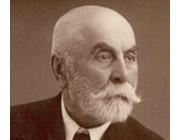
b.18 Sept. 1855, Odobeşti – 1944, Cluj. Band magistrate. Collector of old books and art objects.
Between 1922 and 1923 he donated to the Library of "King Ferdinand" University the most significant part of his collection, comprising 4,500 books, 2000 prints, several hundred photographs, 200 maps, coins, and numerous postcards.
He comes from an old Moldovan family. His mother, Elena Bontaş, one of the most distinguished and influential women in the society of the time, took care of her education, choosing for her son the best schools. In 1869, Iorgu - as he was called in the family - enrolled at the Academic Institute of Iasi, where he passed his baccalaureate in 1874. His mother and uncle, the poet Gheorghe Sion, a member of the Romanian Academy, very much wanted Iorgu to attend a faculty in Bucharest, but he will decide to complete his studies in Paris, leaving the country in the autumn of 1874. On leaving, the young Zion carried letters of recommendation that allowed him to attend the most influential Romanian-French circles in Paris. One of the letters came from the well-known politician Costache Negri who, thanks to his close relationship with the Cuza family, opened the young student's house to Elena Cuza, providing her with a valuable contact with the distinguished Romanian society in Paris. Thus, at the recommendations and under the guidance of the secretary of Madame Elena and Baligot de Beynen, the former secretary of the ruler, as well as his uncle Vasile Alecsandri, Iorgu managed to get to know important teachers and people of culture who guided his path to learning and knowledge. Gheorghe Sion was a highly regarded student and, learning French very quickly, managed to impress his teachers with his brilliant mind. Between 1876 and 1877, he founded the Romanian Society in Paris, a cultural association for Romanians in Paris. He was elected president of this organization, as a sign of the admiration and respect he enjoyed among the Romanian cultural elite in the French capital. From Paris he returned with a solid legal training, which allowed him to enter the judiciary and climb the steps of the judicial hierarchy very quickly.
First, he operated in Bucharest, but declared himself dissatisfied with the capital's suffocating environment, demanding to be transferred closer to his native lands. Shortly after leaving Bucharest, he was appointed, on 21 April 1879, as President of the Tribunal of Piatra Neamț. His professional ascension continued, so that in March 1880 he was appointed first prosecutor at the Iasi Court, and three years later became a prosecutor at the Court of Appeal in the same city. In his old age, feeling called by his native lands, he settled at the estate in Brăteşti, Bacău County, where he gathered with great fondness everything that reminded him of the past of his family and all Romanians. Gheorghe Sion's entire publishing activity is based on a vast knowledge of ancient Romanian history and literature, as well as law studies and jurisprudence.
In all his travels at home and abroad, Gheorghe Sion sought and succeeded in collecting a huge and priceless historical treasure, consisting of old books, manuscripts, documents, prints, photographs, paintings, maps, coins, magazines and many other collectibles.
The University of Iaşi very much wanted to take possession of these treasures, the director of the Central Library of Iaşi, Professor George Pascu, suggesting to Gheorghe Sion the idea of donating his beautiful collection to the Library of the former capital of Moldova. Despite this pressure, but also dissatisfied with the way in which the cultural institutions in the Moldova area were managed and organized, Gheorghe Sion will decide to make a reconnaissance visit to Ardeal, cluj, in order to take a personal interest in the way in which the Library of the "King Ferdinand" University was run and organized. He noticed, with great surprise, but also satisfaction, that it was very well administered by specialists and people, but, just set up to serve romanian education in Cluj, still lacked Romanian books. Satisfied with what he saw, Gheorghe Sion decided that, in 1922, his treasures would take the road to Cluj, where, to the great joy of the Arlene intellectuals, in just a few months they were all inventoried and made available to them. Cluj rewarded this great man, calling him an honorary citizen of the city and received him very quickly in his intellectual circles.
Due to the fact that he also loved his native lands, being a man with fear and love for God, he donated, in October 1935, the villa of the Slănic of Moldova to the Faculty of Law at the University of Iasi. The rest of his estate was donated to the Bishops of Cluj and Iaşi.
Gheorghe Sion spent the last years of his life in Cluj, where his precious treasure and the great treasury were located, for which he worked his entire life. He died in 1944, being buried near his family at Targu Ocna. So far, all those who visit the Church at Magura Ocnei Monastery, which bears the name "The Ascension of the Lord", can see near the altar, outside, the tomb of the illustrious scholar.


